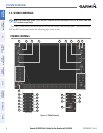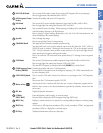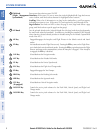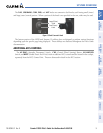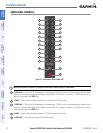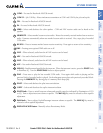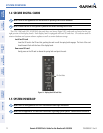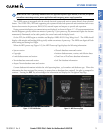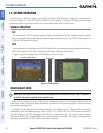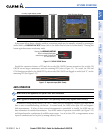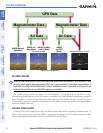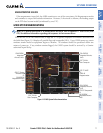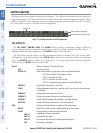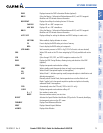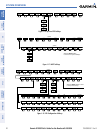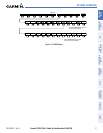
190-00595-01 Rev. B
Garmin G1000 Pilot’s Guide for the Beechcraft A36/G36
14
SYSTEM OVERVIEW
SYSTEM
OVERVIEW
FLIGHT
INSTRUMENTS
EIS
AUDIO PANEL
& CNS
FLIGHT
MANAGEMENT
HAZARD
AVOIDANCE
AFCS
ADDITIONAL
FEATURES
APPENDICESINDEX
1.6 SYSTEM OPERATION
The displays are connected together via multiple data busses, thus allowing for high-speed communication.
As shown in Figure 1-1, each GIA 63/63W is connected to one display. This section discusses the normal and
reversionary modes of operation as well as the various AHRS modes of the G1000 system.
NORMAL OPERATION
PFD
In normal mode, the PFD presents graphical flight instrumentation (attitude, heading, airspeed, altitude
and vertical speed), thereby replacing the traditional flight instrument cluster. The PFD also offers control for
COM and NAV frequency selection.
MFD
In normal mode, the right portion of the MFD displays a full-color moving map with navigation information,
while the left portion of the MFD is dedicated to the Engine Indication System (EIS).
Figure 1-9 gives an example of the G1000 displays in normal mode.
Figure 1-9 Normal Operation
Audio Panel
Primary Flight Display
Multi Function Display
REVERSIONARY MODE
NOTE: The G1000 System alerts the pilot when backup paths are utilized by the LRUs. Refer to Appendix A
for further information regarding system-specific alerts.
In the event of a display failure, the G1000 System automatically switches to reversionary (backup) mode. In
reversionary mode, all important flight information is presented on the remaining display in the same format
as in normal operating mode.
If a display fails, the appropriate IAU Ethernet interface to the display is cut off. Thus, the IAU can no longer
communicate with the remaining display (refer to Figure 1-1), and the NAV and COM functions provided to
the failed display by the IAU are flagged as invalid on the remaining display. The system reverts to backup
paths for the AHRS, ADC, Engine/Airframe Unit, and Transponder, as required. The change to backup paths is
completely automated for all LRUs and no pilot action is required.



